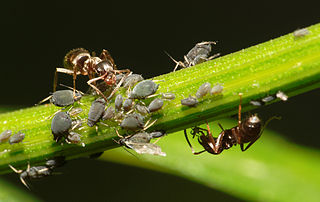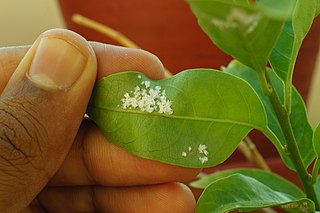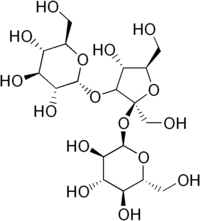
Aphids are small sap-sucking insects and members of the superfamily Aphidoidea. Common names include greenfly and blackfly, although individuals within a species can vary widely in color. The group includes the fluffy white woolly aphids. A typical life cycle involves flightless females giving live birth to female nymphs—who may also be already pregnant, an adaptation scientists call telescoping generations—without the involvement of males. Maturing rapidly, females breed profusely so that the number of these insects multiplies quickly. Winged females may develop later in the season, allowing the insects to colonize new plants. In temperate regions, a phase of sexual reproduction occurs in the autumn, with the insects often overwintering as eggs.

Hemiptera is an order of insects, commonly called true bugs, comprising over 80,000 species within groups such as the cicadas, aphids, planthoppers, leafhoppers, assassin bugs, bed bugs, and shield bugs. They range in size from 1 mm (0.04 in) to around 15 cm (6 in), and share a common arrangement of piercing-sucking mouthparts. The name "true bugs" is often limited to the suborder Heteroptera.

The yellow crazy ant, also known as the long-legged ant or Maldive ant, is a species of ant, thought to be native to West Africa or Asia. They have been accidentally introduced to numerous places in the world's tropics.

Scale insects are small insects of the order Hemiptera, suborder Sternorrhyncha. Of dramatically variable appearance and extreme sexual dimorphism, they comprise the infraorder Coccomorpha which is considered a more convenient grouping than the superfamily Coccoidea due to taxonomic uncertainties. Adult females typically have soft bodies and no limbs, and are concealed underneath domed scales, extruding quantities of wax for protection. Some species are hermaphroditic, with a combined ovotestis instead of separate ovaries and testes. Males, in the species where they occur, have legs and sometimes wings, and resemble small flies. Scale insects are herbivores, piercing plant tissues with their mouthparts and remaining in one place, feeding on sap. The excess fluid they imbibe is secreted as honeydew on which sooty mold tends to grow. The insects often have a mutualistic relationship with ants, which feed on the honeydew and protect them from predators. There are about 8,000 described species.

Protocooperation is where two species interact with each other beneficially; they have no need to interact with each other - they interact purely for the gain that they receive from doing this. It is not at all necessary for protocooperation to occur; growth and survival is possible in the absence of the interaction. The interaction that occurs can be between different kingdoms.

The Aphididae are a very large insect family in the aphid superfamily (Aphidoidea), of the order Hemiptera. These insects suck the sap from plant leaves. Several thousand species are placed in this family, many of which are considered plant/crop pests. They are the family of insects containing most plant virus vectors with the green peach aphid being one of the most prevalent and indiscriminate carriers.

Carpenter ants are large ants indigenous to many forested parts of the world.

Woolly aphids are sap-sucking insects that produce a filamentous waxy white covering which resembles cotton or wool. The adults are winged and move to new locations where they lay egg masses. The nymphs often form large cottony masses on twigs, for protection from predators.

Tapinoma sessile is a species of small ant that goes by the common names odorous house ant, sugar ant, stink ant, and coconut ant. Their colonies are polydomous and polygynous. Like many social insects, T. sessile employs complex foraging strategies, allocates food depending on environmental conditions, and engages in competition with other insects.

Honeydew is a sugar-rich sticky liquid, secreted by aphids, some scale insects, and many other true bugs and some other insects as they feed on plant sap. When their mouthpart penetrates the phloem, the sugary, high-pressure liquid is forced out of the anus of the insects, allowing them to rapidly process the large volume of sap required to extract essential nutrients present at low concentrations. Honeydew is particularly common as a secretion in hemipteran insects and is often the basis for trophobiosis. Some caterpillars of Lycaenidae butterflies and some moths also produce honeydew. In addition to various sugars, honeydew contains small amounts of amino acids, other organic compounds, and inorganic salts with its precise makeup affected by factors such as insect species, host plant species, and whether a symbiotic organism is present.

Camponotus compressus is a type of ground-nesting species of ant found in India and Southeast Asia. It is a frequent visitor to toilets as it consumes urea. It is one of the many species which tends plant-sap-sucking insects like aphids and tree hoppers. They add nutrients into the soil through their discarded waste piles These ants stroke their antenna on the hind parts of these insects stimulating them to excrete a sugar rich liquid, called honeydew, which the ants consume. In return, they are known to protect the insects from predators like ladybugs. These ants range from red to black and some times appear slightly yellow in colour.

Myrmecophily consists of positive, mutualistic, interspecies associations between ants and a variety of other organisms, such as plants, other arthropods, and fungi. It may also include commensal or even parasitic interactions.

Trophobiosis is a symbiotic association between organisms where food is obtained or provided. The provider of food in the association is referred to as a trophobiont. The name is derived from the Ancient Greek τροφή (trophē), meaning "nourishment", and -βίωσις (-biosis), which is short for the English word symbiosis.

Pheidole megacephala is a species of ant in the subfamily Myrmicinae. It is commonly known as the big-headed ant in the US and the coastal brown ant in Australia. It is a very successful invasive species and is considered a danger to native ants in Australia and other places. It is regarded as one of the world's worst invasive ant species.

The black bean aphid is a small black insect in the genus Aphis, with a broad, soft body, a member of the order Hemiptera. Other common names include blackfly, bean aphid, and beet leaf aphid. In the warmer months of the year, it is found in large numbers on the undersides of leaves and on the growing tips of host plants, including various agricultural crops and many wild and ornamental plants. Both winged and wingless forms exist, and at this time of year, they are all females. They suck sap from stems and leaves and cause distortion of the shoots, stunted plants, reduced yield, and spoiled crops. This aphid also acts as a vector for viruses that cause plant disease, and the honeydew it secretes may encourage the growth of sooty mould. It breeds profusely by live birth, but its numbers are kept in check, especially in the later part of the summer, by various predatory and parasitic insects. Ants feed on the honeydew it produces, and take active steps to remove predators. It is a widely distributed pest of agricultural crops and can be controlled by chemical or biological means. In the autumn, winged forms move to different host plants, where both males and females are produced. These mate and the females lay eggs which overwinter.

Coccus viridis is a soft scale insect in the family Coccidae with a wide host range. It is commonly known as green scale or sometimes coffee green scale because it is a major pest of coffee crops throughout the world.

Eriosoma lanigerum, the woolly apple aphid, woolly aphid or American blight, is an aphid in the superfamily Aphidoidea in the order Hemiptera. It is a true bug and sucks sap from plants.

Tuberolachnus salignus, or the giant willow aphid, is a species of aphid, in the genus Tuberolachnus. They are reputed to be the largest aphids, with a body length of up to 5.8mm. First described by Johann Friedrich Gmelin in 1790, it feeds on many species of willow, and has one known host-specific parasite, Pauesia salignae.

Niphanda fusca is a parasitic butterfly primarily found in East Asian countries such as Japan and Korea. It is a "cuckoo-type" parasite of the ant Camponotus japonicus. It utilizes chemical mimicry to trick the host worker ants into adopting it while it is a third-instar caterpillar. From there, it is fed mouth-to-mouth by the worker ants as though it were one of their own young.
Paracletus cimiciformis is a species of aphid with a complex life cycle. Its primary host plant is Pistacia and its secondary host is a grass, where it is present on the roots. Here it is associated with an ant and part of its life cycle is spent in the ant's nest.




















